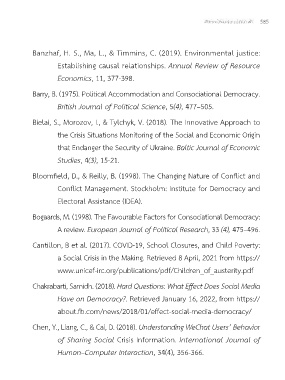Page 586 - kpiebook67020
P. 586
585
Banzhaf, H. S., Ma, L., & Timmins, C. (2019). Environmental justice:
Establishing causal relationships. Annual Review of Resource
Economics, 11, 377-398.
Barry, B. (1975). Political Accommodation and Consociational Democracy.
British Journal of Political Science, 5(4), 477–505.
Bielai, S., Morozov, I., & Tylchyk, V. (2018). The Innovative Approach to
the Crisis Situations Monitoring of the Social and Economic Origin
that Endanger the Security of Ukraine. Baltic Journal of Economic
Studies, 4(3), 15-21.
Bloomfield, D., & Reilly, B. (1998). The Changing Nature of Conflict and
Conflict Management. Stockholm: Institute for Democracy and
Electoral Assistance (IDEA).
Bogaards, M. (1998). The Favourable Factors for Consociational Democracy:
A review. European Journal of Political Research, 33 (4), 475–496.
Cantillon, B et al. (2017). COVID-19, School Closures, and Child Poverty:
a Social Crisis in the Making. Retrieved 8 April, 2021 from https://
www.unicef-irc.org/publications/pdf/Children_of_austerity.pdf
Chakrabarti, Samidh. (2018). Hard Questions: What Effect Does Social Media
Have on Democracy?. Retrieved January 16, 2022, from https://
about.fb.com/news/2018/01/effect-social-media-democracy/
Chen, Y., Liang, C., & Cai, D. (2018). Understanding WeChat Users’ Behavior
of Sharing Social Crisis Information. International Journal of
Human–Computer Interaction, 34(4), 356-366.

